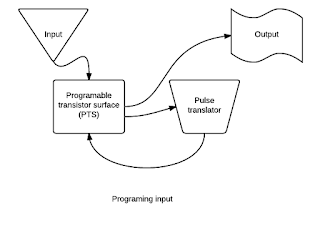Most conventional circuit chips are made with a square grid, but maybe it would be a better idea to use a hexagonal grid, which has more vertexes per area. This might make them more space efficient, but it might also not.
Just saying.
Friday, March 10, 2017
Wait, there could be one use-like thing...
If you connected a gray scale camera to a programmable transistor surface you could use it to make connections within the computer using photos to program the PTS. I don't know how this could be useful, but it's an interesting way to directly program computers with pictures.
Self programming transistor surfaces
OK here it is: (I don't actually expect anyone to understand it, since I was just writing down everything I'm thinking, I just put it on this blog for me to remember and other people to see what I was doing)
I was thinking about variably conductive programmable surfaces. Basically it would be a surface which changes its conductivity based on what electricity is going in to the parts of it. people could make circuits that program themselves based on inputs, and then program themselves differently when the inputs are processed, then reprogram themselves again, as many times as necessary. I don't actually know how useful it would be, or how it could reprogram itself, since to program itself it would have to have more outputs then inputs, and since it's a plane with a 1D outside with outputs and a 2D inside with the outputs, this seems impossible, unless the inputs and outputs are switched somehow, but I don't know how that would work. It may be a good way to process pictures, or somehow draw physical circuits.
There is a way! I realized how the output could connect to the inputs- they could use binary pulses which a conventional chip could recognize and translate the pulses into direct non binary signals which could be used as the input to program the chip and make a new program.
I was thinking about variably conductive programmable surfaces. Basically it would be a surface which changes its conductivity based on what electricity is going in to the parts of it. people could make circuits that program themselves based on inputs, and then program themselves differently when the inputs are processed, then reprogram themselves again, as many times as necessary. I don't actually know how useful it would be, or how it could reprogram itself, since to program itself it would have to have more outputs then inputs, and since it's a plane with a 1D outside with outputs and a 2D inside with the outputs, this seems impossible, unless the inputs and outputs are switched somehow, but I don't know how that would work. It may be a good way to process pictures, or somehow draw physical circuits.
There is a way! I realized how the output could connect to the inputs- they could use binary pulses which a conventional chip could recognize and translate the pulses into direct non binary signals which could be used as the input to program the chip and make a new program.
Subscribe to:
Posts (Atom)
